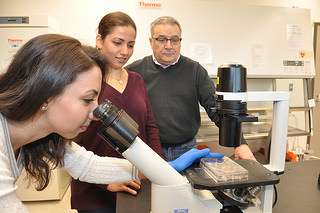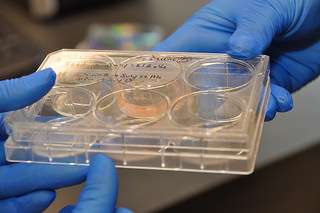Lab creates potentially life saving heart cells

A group of Simon Fraser University researchers' cultivation of dozens of beating heart cells in Petrie dishes could one day save or improve the lives of patients with inherited heart arrhythmias. They are genetic mutations that cause irregular heartbeats that can be lethal.
Elham Afshinmanesh and Sanam Shafaattalab, graduate students in SFU's molecular cardiac physiology lab, have created the heart cells, also known as cardiomyocytes, beating in unison. They've been crafted from the skin of heart arrhythmia patients.
Because the beating heart cells share the same genomes as the patients, these cells also mimic the patients' diseases, permitting scientists to experiment with potential drug therapies and interventions.
The students are working under the supervision of Glen Tibbits, an SFU professor and Canada Research Chair in Molecular Cardiac Physiology. They are collaborating with cardiologists, who specialize in inherited cardiac arrhythmias, at B.C. Children's and St. Paul's hospitals.
Their research is key to developing one of the first laboratories capable of testing cardiomyocytes in vitro and then recommending customized treatment for individuals who have these inherited heart diseases.
"It's often very challenging for clinicians to assess risk in these patients," explains Tibbits.
"It is frequently difficult to determine whether a patient has a high likelihood of suffering from cardiac arrest or will be okay by simply taking a beta blocker and/or other medications.
"The idea behind our work is to test, with the patient's own cells, what therapies might work, or not."
The research is new and complex, and they are optimizing the methods by which a patient's blood cells can be reprogrammed into induced pluripotent stem cells, which can then become any kind of cell. They have already mastered the ability to turn skin cells into this type of stem cell (iPSC), but would prefer to work with the patient's blood, since this is more efficient and less invasive than using skin biopsies.
Says Afshinmanesh, "When we convert the blood and skin cells to stem cells not all of them can be further differentiated into heart cells. So we're looking for markers that will predict which stem cells are good prospects for becoming heart cells."

Tibbits expects that within the next few months his lab will be ready to begin testing the beating heart cells with therapeutic interventions to determine the efficacy of individual treatments.
"We have grants to support our work right now, but eventually we hope that these tests will become part of the Medical Services Program," explains Tibbits. "Then we will isolate the skin or blood cells, convert them, determine the appropriate patient therapy and then be reimbursed."
















